Recently I get the feedback from some of my readers that they are confused about the sauces and pastes mentioned in the recipes from this blog or other places introducing real Chinese recipes. Either you are familiar with Chinese cooking or not, the large ground of sauces used in Chinese recipes sometimes can be quite confusing. This is a post to guide you from the beginner to advanced Chinese cooking–using different types of sauces and paste for flavoring. It include introduction of various Chinese sauces, pastes, cooking wine, vinegars and oil.
Soy Sauce(酱油)
Soy sauce should be come firstly since it is the basic for many stir-fry sauces. Soy sauce is a traditional seasoning for Chinese recipe which is made from soy beans, wheat and wheat bran (麸皮). It has a mildly salty flavor and bright red color after fermentation.
There are three types of soy sauce: light soy sauce, dark soy sauce and soy sauce pastes. They perform differently in dishes.
Light soy sauce(生抽) has a lighter color than dark soy sauce and it mainly used for adding the flavor. So it is commonly used in stir fry dishes, salad, noodle soups and dipping sauces. So for most Chinese stir-fry recipe, if only soy sauce is called, use light soy sauce!
Dark soy sauce(老抽) is the common soy sauce with caramel. With a darker the color. It is mainly used for adding the color of the dish. For example in most red-braised dishes, dark soy sauce usually is used.
Soy sauce paste (酱油膏) is sweeteded soy sauce with a thicker texture (quite similar to oyster suace), extremely popular in Taiwan. The most famous brand of soy sauce paste is Kimlan. It can be used in stir-fries, dipping sauces and red-braising (especially taiwan style red-braising like Luroufan.) More details about how it is used in Taiwanese cuisine, check here.
Doubanjiang (豆瓣酱)
For the western part of China, broad bean paste or doubanjiang (豆瓣酱)is a typical chili sauce from Sichuan china.It is the most important ingredients for lots of famous Szechuan dishes, including twice cooked pork belly, mapo tofu, and Sichuan style water boiled fish. After long time fermentation, doubanjiang has a unique spicy flavor.
There are several Pixian doubanjiang brands in China but only 2 of them popular outside China (Juancheng and DanDan). Housewives in Sichuan province love to make red oil doubanjiang, which is usually kept in a jar.
Chili Oil and Sauces(辣椒油和辣椒酱)
Laoganma(老干妈)
If you ever visit any Chinese restaurants, you will find chili oil or chili sauces on the table as a customer self-serve sauce. They can almost go well with everything Chinese. A dumpling dipping sauce, a bowl of congee, warm noodles soups or even steamed buns. They are several types of chili oil and sauces that are loved by Chinese foodies. The most famous one might be Laoganma (老干妈), we sometimes joke that she is the godmother of all lazy Chinese foodies. Back in 1996, Tao Huabi opened a small shop selling noodles, but she became quite popular due to her great taste chili sauce. Years later, after shutting down the small shop, Tao Huabi devoted herself into a chili sauce production line. The two most popular chili oils from Laoganma are crisp chili oil and black bean chili oil. And I love chicken oil chili sauce too. In most cases, they bring quite good tastes in most stir-fry dishes, soups, dipping sauces and cold salad. Laobanma has obtained high popularity outside China. You can find them in Asian markets and groceries.
Besides the Godmother, there are other two dominating chili sauce widely used in Sichuan cuisine and Hunan cuisine–Szechuan chili oil(川味红油) and Hunan chopped chili(湖南剁椒).
Szechuan chili oil, sometimes is simplified as Chinese chili oil is made with red pepper flakes, spices and oil. With a well balanced mala taste, it is one of the most essential ingredients for lots of Sichuan dishes like red oil wonton, mouthwatering chicken and dan dan noodles.
Hunan chopped chili (湖南剁椒) is a slightly fermented chili paste with a much fresher taste with a slight touch of sour taste. Usually garlic and ginger are also called for common Hunan chopped chili. It is super great with steamed food like steamed fish head, steamed baby taro and etc.
Fermented Black Beans or Dou-chi (豆豉)
Fermented black beans are made of fermented salted black beans and rice wine. They have a savory and slightly salty flavor. In most cases, fermented black beans can be used in steamed recipes for example steamed ribs and in grilled fish. Spicy black bean sauce is made from fermented black beans, spices and oil. One of the most popular brand in China is Lao Gan Ma Black Bean Chilli Sauce, 280g.
Cooking Wine (料酒)
Chinese cooking wines play really important roles in most Chinese seafood recipes and meat dishes. The highest quality (Huadiao) is a pure yellow wine. Based on yellow wine and white wine, Chinese developed their cooking wine (Liaojiao) by adding other seasonings. Generally, Liaojiu is much cheaper than Huadiao.
Brown Bean Paste(Sweet Bean Paste 甜面酱)
Brown bean paste also known sweet bean paste is quite popular in northern part of China and in Sichuan area. It is the main dipping sauce for the famous Beijing roasted duck (北京烤鸭). Brown bean paste usually is made from soy beans and flour with a special fermentation process. The sweet tastes come from the maltose and glucose in the fermentation process, and the fresh tastes come from the amino acid. Then salt is added to balance the taste.
Sha Cha Sauce(沙茶酱)
Sha Cha Sauce (沙茶酱) is a complex sauce popular in Southern China, Guangdong province and Taiwan area Mild Sha Cha Sauce have a slightly sweet taste. There are several different varieties in China. But all of them require a huge group of ingredients including peanuts, sesame paste and spices. The most popular way of using Sha Cha sauce is the dips of hot pot, especially Beef hot pot. Personally I love Taiwan bull head..
Hoisin Sauce (海鲜酱)
Hoisin sauce or hoisin paste has a dark, rich and spicy-sweet flavor. The color is reddish brown. Usually hoisin is made from soybeans, garlic and Chinese spices. It also can be used in dips for hot pot or marinating for meat like Hoisin pork with steamed buns.
Char Siu Sauce(叉烧酱)
Char siu sauce is quite popular in sorthern part of china. It is a salty and sweet sauce made of soy sauce, vinegar, chili, garlic, sugar and Chinese five spicy powders. It is a perfect sauce for chicken wings, char siu pork and ribs. You can buy store bough Char Siu Sauce or match one using other ingredients.
Sesame Paste (芝麻酱)
Sesame paste is made of roasted sesame seeds and it is also called as 麻酱 in China. From the color, we have white sesame paste and black sesame paste. It is the magic paste for lots of yummy Chinese dishes. With just a small amount, sesame paste can greatly improve the tastes of noodles (Wuhan Hot and dry noodles, Dan Dan noodles, Szechuan cold noodles).
Sesame Oil (芝麻油)
Due to the distinctive nutty aroma and taste, sesame oil is one of the most important flavor enhancer in Chinese cooking. It almost can go well with everything Chinese like steamed eggs, stir fries, soups, dips and salad. In most cases, Chinese sesame oils are toasted pure sesame oil, either white sesame oil or black sesame oil.
Oyster Sauce (蚝油)
Oyster sauce has a sweet and salty taste and with some smoky feeling. Commonly oyster sauce is made from oyster extracts, sugar, water, soy sauce and wheat flour. It is a seasoning for beef and fish recipes.Oyster sauce in mainly used in Guangdong Cuisine.
Vinegar (醋)
Generally we have white vinegar, black vinegar and red vinegar (mainly popular in Zhejiang province) in China. Unlike the fruit and wine vinegar popular in western cuisines, vinegar in China is fermented based on grains (rice usually glutinous rice), wheat bran and sorghum.
In most cases, black vinegar is widely used due to its aroma. Red vinegar is mainly used as dips or coloring for roasted meat. While white vinegar is used when sour taste is required but no influence on the color for example quick pickles (跳水泡菜).
There is a very thick and different mature vinegar (老陈醋), mainly produced in Shanxi province. Mature vinegar is fermented based on peas, sorghum, wheat, salt and spices. It has a longer history than rice based vinegar. The taste of mature vinegar is also much stronger and more complex than other common cooking vinegars in China. As a result, it might be the best choice for dipping sauces.
Recommendations
| Name | Usage | Where to buy |
| Dark soy sauce | Coloring, red-braising dishes | Amazon: https://amzn.to/2xpqamC |
| Light soy sauce | Flavoring, dipping ,salad | Amazon: https://amzn.to/2pejYKw Amazon: https://amzn.to/2xpKm7F |
| Seasoned Soy Sauce | Steamed dish,dipping | Amazon: https://amzn.to/2DyM7pq |
| Soy sauce paste | Taiwanese red-braising | Amazon: https://amzn.to/2xgiiV5 |
| Doubanjiang | Soul of Sichuan dishes | Amazon: https://amzn.to/2OtKiLE Amazon: https://amzn.to/2xo22lh {homemade by Elaine } : https://goo.gl/ouYOs4 |
| Laoganma crisp chili oil | Dipping, soup, noodles, fried rice | Amazon: https://amzn.to/2xjCwN0 |
| Laoganma black bean chili oil | Dipping, soup, fried rice, fried noodles | Amazon: https://amzn.to/2xwDHZN |
| Sichuan oil | Dipping, noodles | {homemade by Elaine } : https://goo.gl/Uh3cl3 |
| Hunan Chopped chili | Dip, steamed dishes, noodles | {homemade by Elaine } : https://goo.gl/L9NOir |
| Fermented Black Beans | Stir-fry, marinating, soups | Amazon: https://amzn.to/2xjUFLr |
| Cooking wine (Liaojiu) | Seafood, marinating | Amazon: https://amzn.to/2MxpL7b |
| Cooking wine (Hua Diao) | Seafood, marinating, stir fry | PosharpStore: https://goo.gl/cMg0bY |
| Sweet Bean Sauce | Dip, stir-frying, soup | Amazon: https://amzn.to/2xN8QIo |
| Sha Cha Sauce | Dip, flavoring, fried rice, roasted meat | Amazon: https://amzn.to/2wUEbIv |
| Hoision sauce | Dip, marinating ,stir fry | Amazon: https://amzn.to/2OvqJCy |
| Char Siu Sauce | Marinating | Amazon: https://amzn.to/2peF1wg |
| Sesame paste | Dip, noodles, | Amazon: https://amzn.to/2pc6DCn |
| Sesame oil | Dip, soup, steamed dishes, stir fry | Amazon: https://amzn.to/2Or5v96 |
| Oyster sauce | Stir-frying, marinating, dip | Amazon: https://amzn.to/2NeEwAS |
| Black vinegar | Dip, stir-frying, marinating | Amazon: https://amzn.to/2xnCtQg |
| White vinegar | Dip, pickles | Amazon: https://amzn.to/2xpwdaR |
| Fermented tofu | Dip, side dish, marinating | Amazon: https://amzn.to/2xpw6Mj |

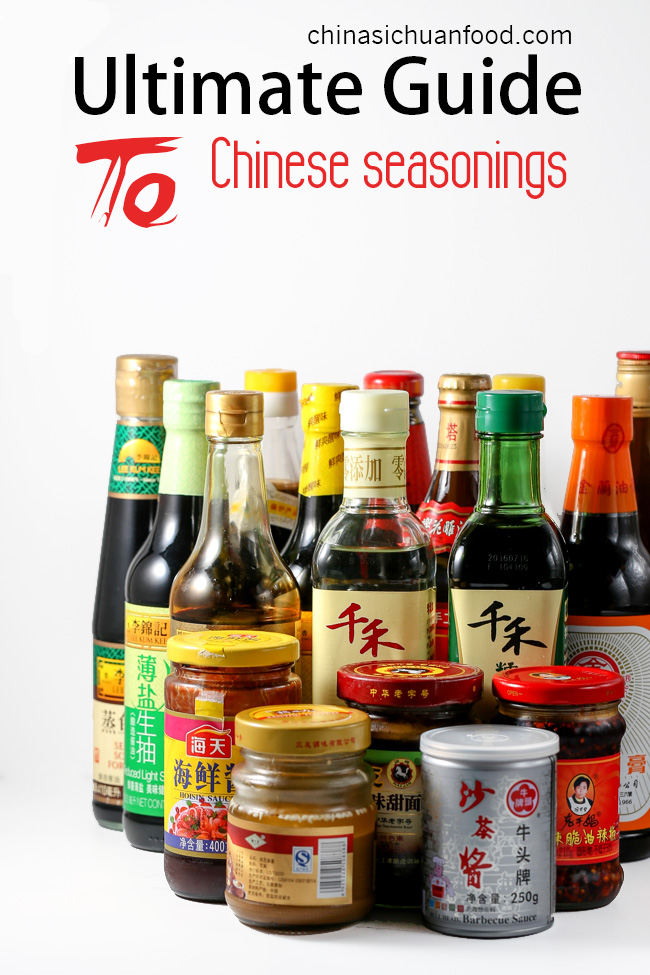
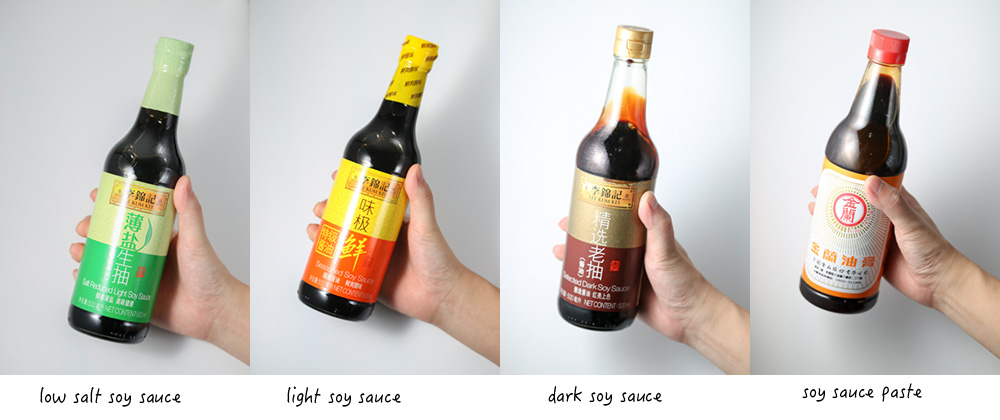
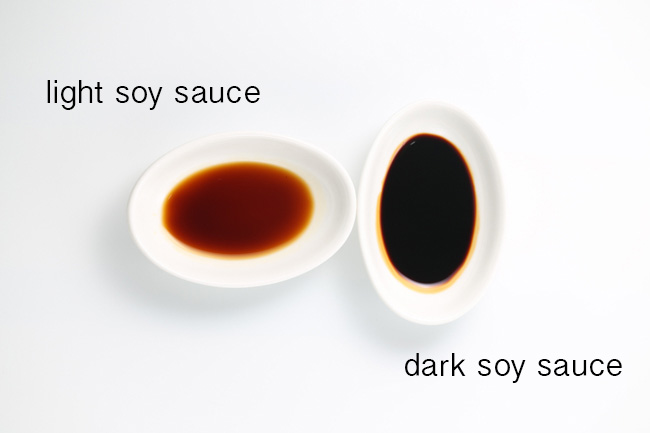
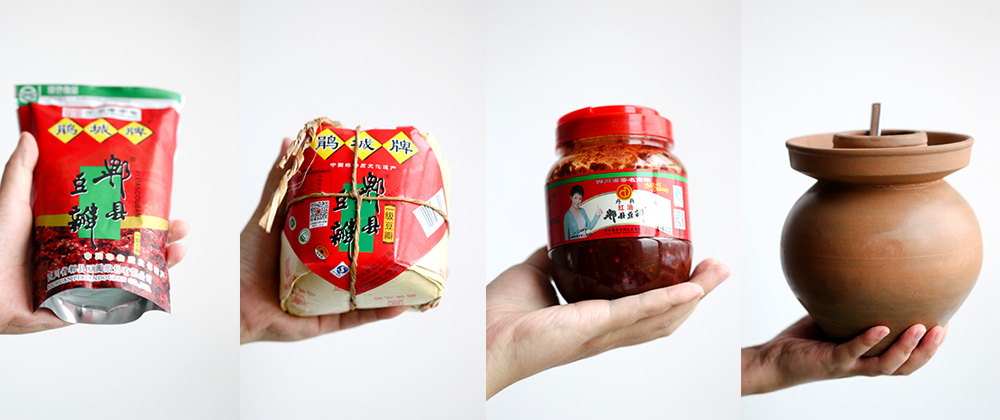
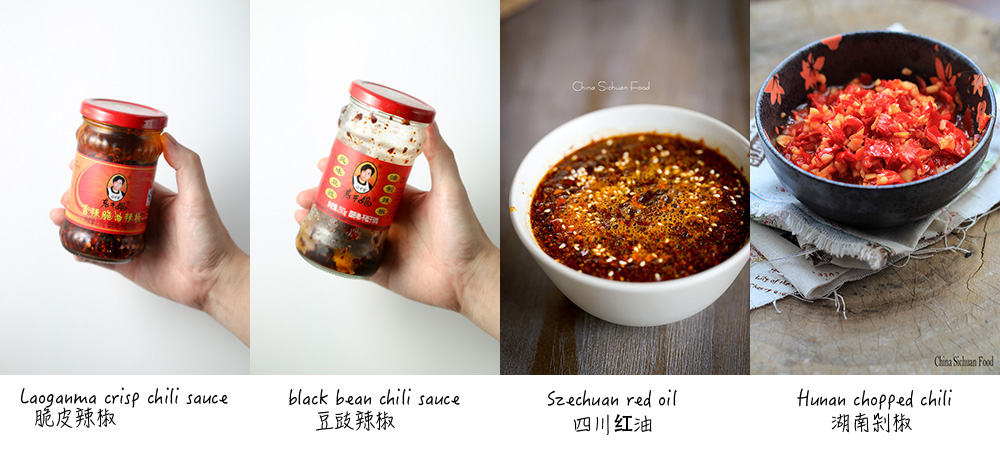
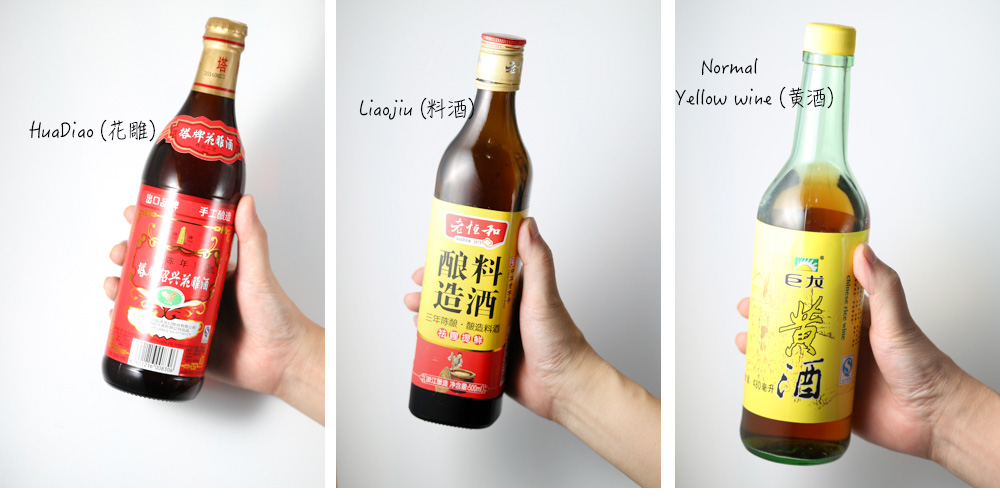
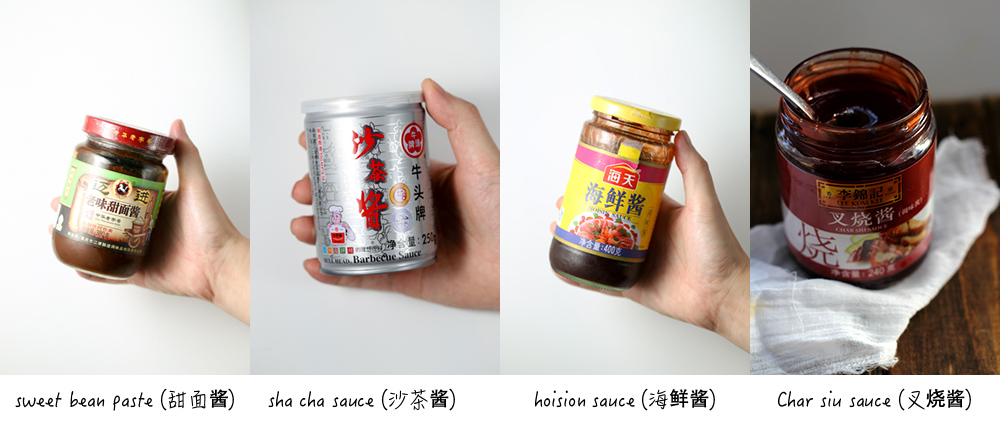
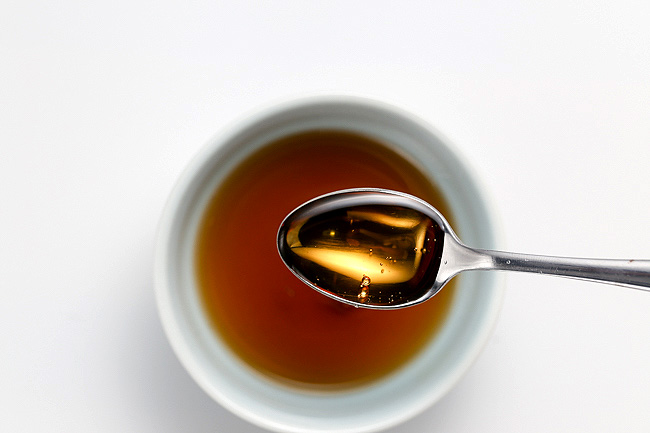
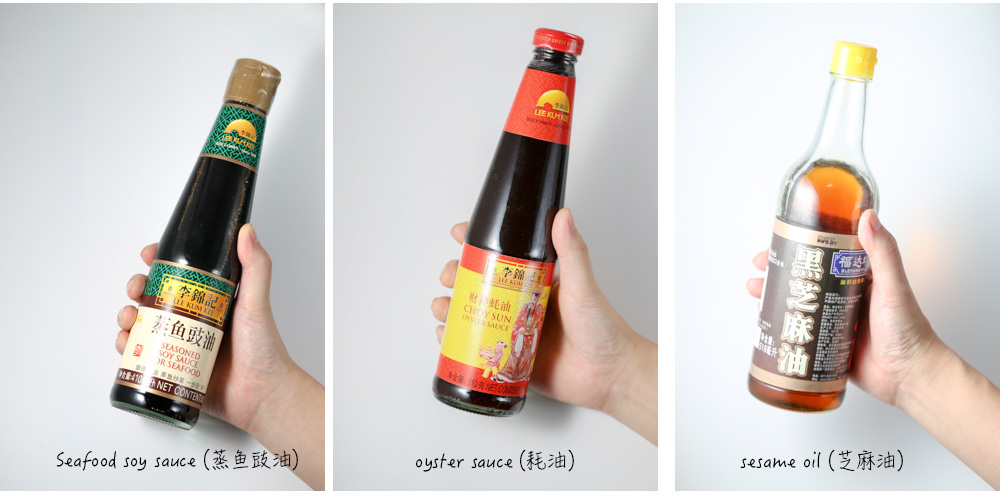
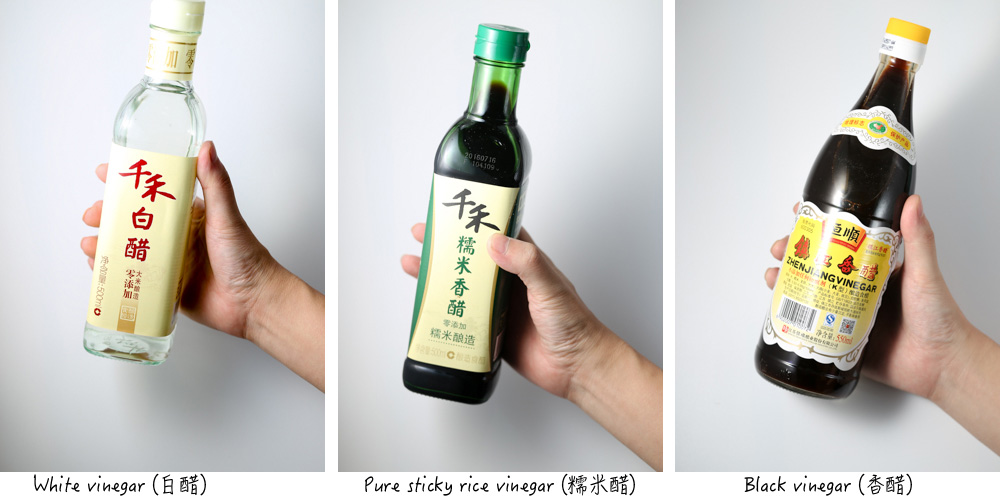
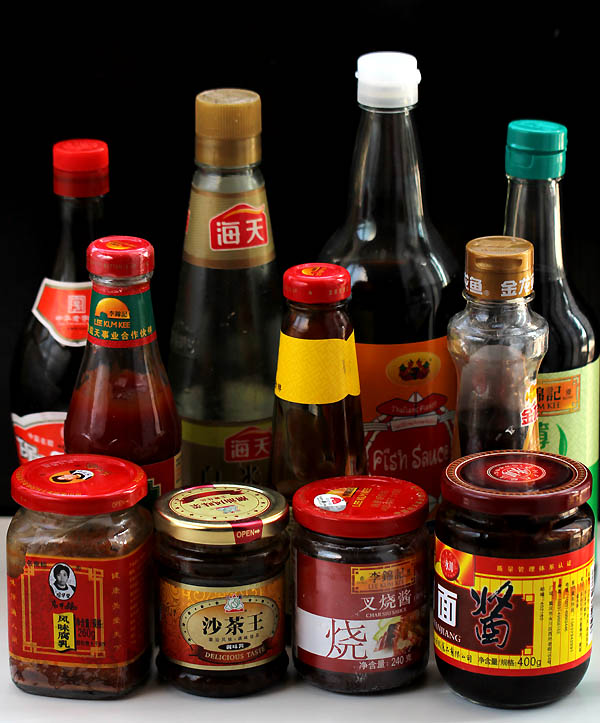
All those seasoning look so familiar. I’ve seen them around my house since I was young but what I have no idea are Sichuan seasoning such as doubanjiang, Lao gan ma black bean chili sauce, Sichuan peppercorn oil and different spices used in Sichuan hot pot and hot pot sauce.
I just bought Lao gan ma black bean chili sauce a week ago because the sichuan restaurant told me they added this sauce into mapotofu. Still in my fridge cos I don’t know how to use it.
I took a lot of sichuan dishes photo I would like to show you. If there is anyway I could send them to you? Email?
Hi Lin Wen,
For sichuan style hot pot, doubanjiang, black bean, sichuan peppercorns are must. And also there are other spices used including 草果 (Cǎo Guǒ) Cardamom,大茴香/八角 (Dà Huí Xiāng/Bā Jiǎo) Star Anise,茴香 (Huí Xiāng) Fennel Seeds,桂皮 (Guì Pí) Cinnamon,山奈 (Shān Nài) Kaempferia Galanga,白豆蔻 (Bái Dòu Kòu) White Cardamon and Black cardamom.
If you have lao gan ma black bean chili sauce, I recommend use to grill fish or steam ribs. There is a recipe https://www.chinasichuanfood.com/soybean-ribs/
If you get any pictures, yes, you can send me via Email.
Hi Elaine, whats the difference between rice wine and cooking wine? is mirin a rice or cooking wine?
greeting from germany
.
luisa
Hi Luisa,
Cooking wine is a group name for all wine used in meat dishes to remove the raw taste, usually made from glutinous rice with other spices . Rice wine itself can be drink directly in China. Mirin is a Japanese culinary combined wine similar to rice wine. But personally, I am not familiar with mirin too.
thank you, so i better go and get a cooking wine and a rice wine 🙂 can i use shaoxing wine as a cooking or as a rice wine?
have you ever heard of sardee sauce?
Do you mean Satay sauce? I never heard of sardee sauce before.
I would like to know how to make these sauces at home! I like fermenting things…
Nice sauce
I want make all Chinese food
Well, that’s a wonderful and lovely ambition. Good luck with your kitchen adventure!
Thank you so much for the introduction. I think my question that I asked you yesterday is answered here.
You are the most welcome! Thida
Hi, I recently asked the lady at our favourite Chinese restaurant what spice went into her satay sauce. She told me but I really couldn’t her and didn’t want to be rude. I did understand that it was not chilly but some spicy sauce. Would you have any idea what it might be.
Hi Jack,
I am quite sorry that I cannot figure out the exact answer based on the above information. If the lady is using satay, I think possibly it is spicy sha cha sauce.
If you have 50 people making Satay sauce you’ll have 75 different recipes … there is no ONE Satay sauce.
I love experimenting and must have made Satay at least 250 different ways … but have never been able to replicate one GREAT tasting combination I made somewhere around 20 years ago. Actually made it in bulk (about 8 liters) for a tennis tournement and had people begging for the recipe .. I wish I’d written it down.
My basic recipe starts of course with the base peanut butter, a very big dose of salty soya sauce, garlic to taste (with me that’s LOTS) and a tablespoon of a medium curry powder with coconut milk or just water, first frying the garlic and curry in butter.
and adding any combination of other spices as the mood takes me ..
Spices such as ginger powder, kardemon, fenugreek, chilli paste, celery salt, paprika and anything else I find in the cupboard …. but just don’t OVER-taste.
Just make sure that it warms up VERY SLOWLY and NEVER EVER boils, the oil will split out of the sauce ,, if it does you can resurrect it to an extent by addding water but it will definitely not be the same.
Waiting to see what the result is each time is 95% of the fun.
Hi, could you tell me what tauban sauce is please?
Hi Clare,
touban is the board bean past in China. I have updated the article and hope it can help more.
hi elaine, is there a way to substitute doubanjiang with some other chili sauce?
Hi Dave,
Honestly, I really do not recommend replacing doubanjing for real Sichuan dishes. It is so unique and a great partner with fermented black beans. However for freestyle home cooking dishes, you can replace it with other fermented savory chili paste for example Korean style chili paste.
hi again elaine, i managed to get some chili bean sauce from chinatown. https://www.wingyipstore.co.uk/fu-chi-chilli-bean-sauce-jar-400g.html is this the same as doubanjiang??
No Dave,
This version is not traditional Sichuan style Doubanjiang, as I see it is made from soy beans instead of fava beans.